numos
Hazard to Others
  
Posts: 269
Registered: 22-2-2014
Location: Pasadena
Member Is Offline
Mood: No Mood
|
|
Copper I Mercury iodide
Everyone is familiar with Mercury II iodide, the bright orange compound that transitions to yellow when heated. However an easy follow up is Copper I
mercury iodide, which can be made quite easily and is just as spectacular. Found this here on page 192. Essentially the procedure describes mixing Mercury II iodide and Copper I iodide and heating. It's a little vague but here's
what I made of it:
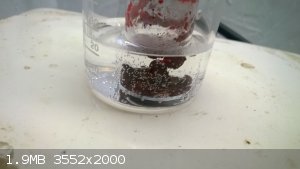
I stirred Mercury II iodide and Copper I iodide together with a few mL water in a vial and placed that whole thing in a beaker with water. The
reaction was actually rather quick, as soon as the tiny "pre-boil" bubbles appeared it was already a deep brown as seen in the picture above. After
filtering and washing with Acetone it transitioned to a deep red and looked like this.
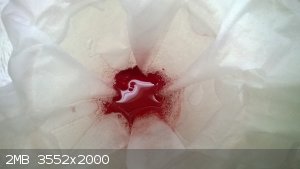 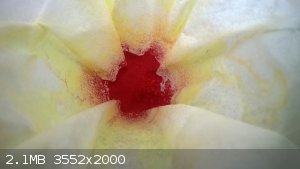 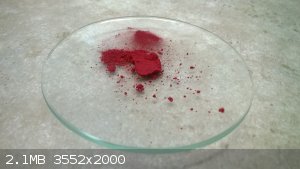
If you look at the pictures carefully a few specks of orange can be seen, which I'm sure is simply unreacted HgI2. I think this is due to
two reasons, one the mixture wasn't mixed enough, the orange apeared as little clumps, meaning much of the HgI2 in the clumps didn't even
have a chance to react, and second, further heating might be beneficial. I took it off heating after no more change was observed, but I suppose it
wasn't quite ready.
This formula is Cu2HgI4, indicating the reactants are literally just fused together, the compound is thermochromic as well,
changing to brown when placed in hot water (67oC according to Wikipedia) Personally I like this more than Mercury II iodide because it can be done in hot water and direct heating is not necessary.
This next bit doesn't have much to do with thermochromism, but when I filtered the product and washed with acetone, this was the waste product:
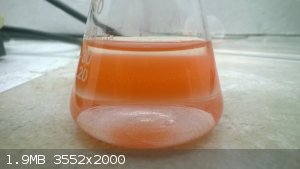 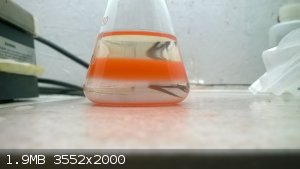
I'm guessing the water and acetone separated (I think the water may be slightly denser due to dissolved Mercury compounds) and there is a layer of
ultra fine HgI2 that passed through the filter floating between. This is why I love chemistry - even the freaking waste is beautiful...
|
|
|
Volanschemia
Hazard to Others
  
Posts: 340
Registered: 16-1-2015
Location: Victoria, Australia
Member Is Offline
Mood: Pretty much all of them!
|
|
Nice! Would have been nice if someone had made this for my copper competition! I'll have to make some, I have all the reagents needed.
"The chemists are a strange class of mortals, impelled by an almost insane impulse to seek their pleasures amid smoke and
vapor, soot and flame, poisons and poverty; yet among all these evils I seem to live so sweetly that may I die if I were to change places with the
Persian king" - Johann Joachim Becher, 1635 to 1682.
|
|
|
woelen
Super Administrator
        
Posts: 7977
Registered: 20-8-2005
Location: Netherlands
Member Is Offline
Mood: interested
|
|
Nice to see that other persons tried this as well. I also did this experiment:
http://woelen.homescience.net/science/chem/exps/hgi2_thermoc...
A similar thing also works for silver(I) ions, as I describe in my webpage.
|
|
|
aga
Forum Drunkard
    
Posts: 7030
Registered: 25-3-2014
Member Is Offline
|
|
Beautiful !
Very nice photos numos.
|
|
|